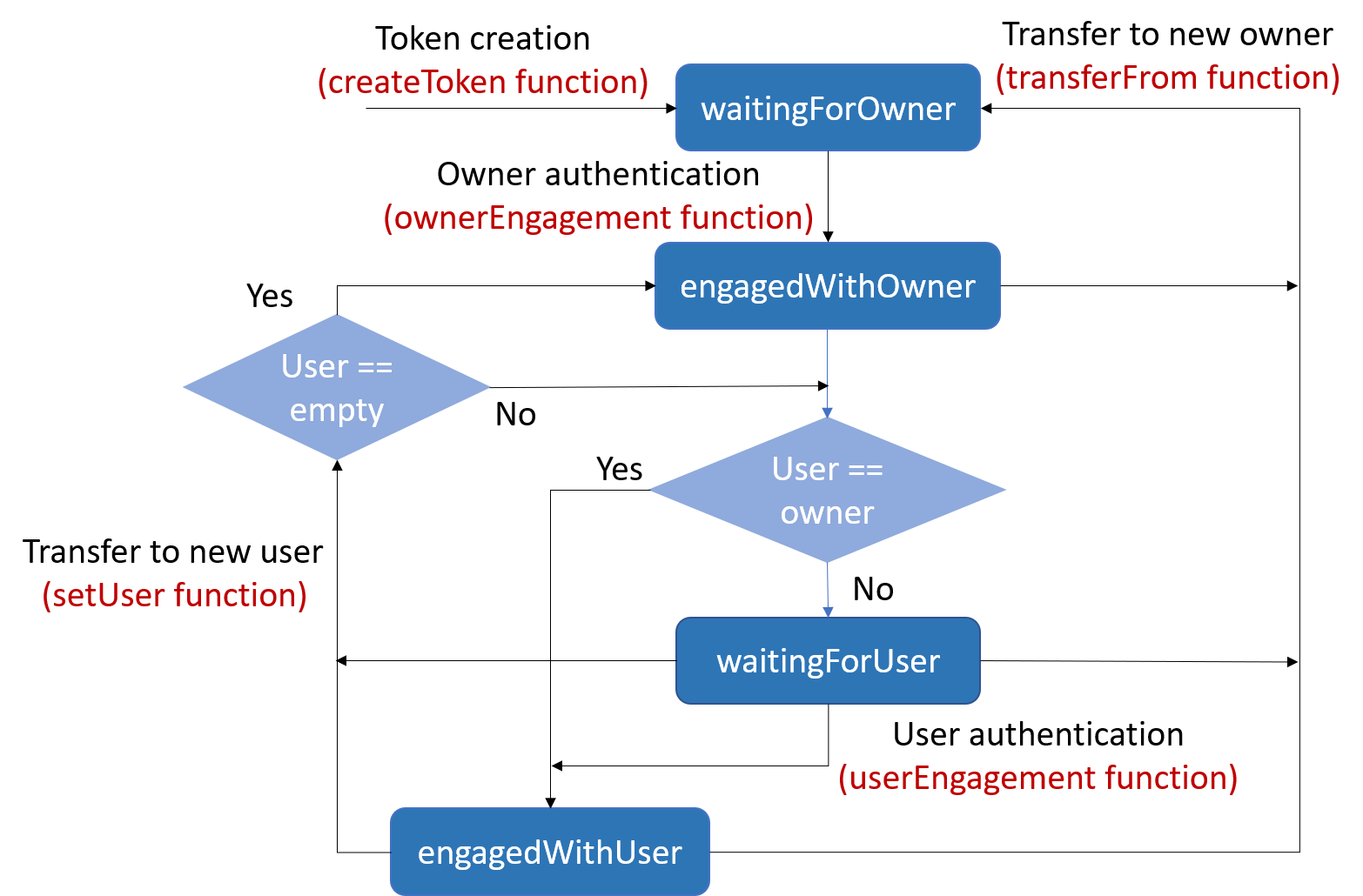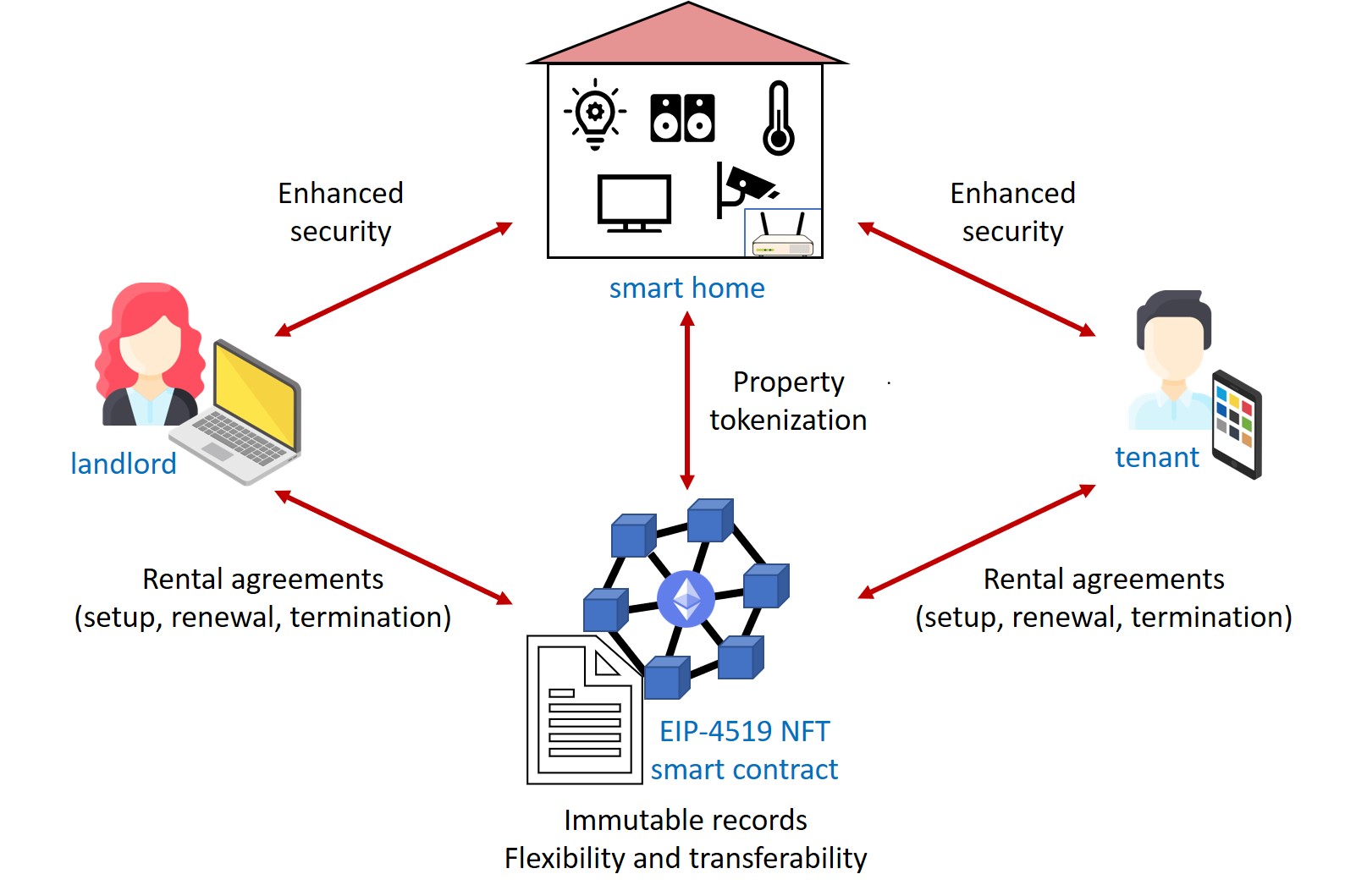The rental of houses is a common economic activity. However, there are many inconveniences that arise when renting a property. The lack of trust between the landlord and the tenant due to fraud or squatters makes it necessary to involve third parties to minimize risk. A blockchain (such as Ethereum) provides an ideal solution to act as a low-cost intermediary. In particular, the use of non-fungible tokens (NFTs) based on ERC-4519 is very interesting for smart home tokenization. The ERC-4519 is an Ethereum standard for describing NFTs tied to physical assets, allowing smart homes (assets) to be linked to NFTs so that the smart homes can interact with the blockchain and perform transactions, know their landlord (owner) and assigned tenant (user), whether they are authenticated or not, and know their operating mode (NFT state). The payments associated with the rental process are made using the NFT, eliminating the need for additional fungible tokens and simplifying the process.
- blockchain
- smart home
- Internet of Things
- IoT
- smart contract
- real estate
- non-fungible token
- NFT
1. Blockchains (particularly Ethereum) for the Rental of Smart Homes
| Refs. | Focus on Rental |
Focus on Property Transference | IoT-Based Access Control |
Avoidance of Intermediaries | Home Tokenization |
|---|---|---|---|---|---|
| [1] | Yes | No | No | Yes | No |
| [2] | Yes | No | No | Yes | No |
| [3] | Yes | No | No | No | No |
| [4] | No | Yes | Yes | Yes | No |
| [5] | Yes | No | Yes | Yes | No |
| [6] | No | Yes | No | Yes | Yes (Fungible) |
| [8] | No | No | Yes | Yes | No |
| [10] | No | Yes | No | Yes | Yes (Non-Fungible) |
| Refs. | ERC Name | NFT with Users | NFT Tied to Asset | NFT with States | NFT Enabling Secure Communication | Status |
|---|---|---|---|---|---|---|
| [9] | ERC-721 | No | No | No | No | Final |
| [7] | ERC-777 | No | No | No | No | Final |
| [11] | ERC-1155 | No | No | No | No | Final |
| [12] | ERC-4494 | Yes | No | No | No | Draft |
| [13] | ERC-5334 | Yes | No | No | No | Draft |
| [14] | ERC-4907 | Yes | No | No | No | Final |
| [15] | ERC-5187 | Yes | No | No | No | Draft |
| [16] | ERC-5501 | Yes | No | No | No | Draft |
| [17] | ERC-2615 | Yes | No | No | No | Stagnant |
| [18] | ERC-4519 | Yes | Yes | Yes | Yes | Final |
2. ERC-4519: Non-Fungible Tokens Tied to Physical Assets

3. Using ERC-4519 NFTs for the Rental of Smart Homes

| Type | Attributes | Type | Attributes |
|---|---|---|---|
| uint256 | tokenId | uint256 | deposit |
| address | owner | uint256 | rentalPrice |
| address | user | uint256 | waterMeter/waterPrice |
| address | asset | uint256 | dieselMeter/dieselPrice |
| enum States | state | uint256 | gasMeter/gasPrice |
| uint256 | hashK_OA | uint256 | electricityMeter/electricityPrice |
| uint256 | hashK_UA | uint256 | rentalTime |
| uint256 | dataEngagement | uint256 | homeIssues |
| uint256 | timestamp | struct | Expenses_Meters |
| uint256 | timeout | struct | Expenses_Prices |
A smart home is defined by an Internet-of-Things (IoT) gateway and end devices (such as sensors that measure water, diesel, gas, or electricity consumption). The IoT gateway is in charge of facilitating communication between the end devices, both amongst themselves and with the cloud. It also manages data to/from the end devices and provides security to the smart home by mitigating risks. Since the IoT gateway is the central device of the smart home, it is considered the asset tied to the ERC-4519 NFT.
| Function Name | Input Attributes |
|---|---|
| createToken | asset, owner |
| transferFrom | tokenId, addressFrom, addressTo |
| setUser | tokenId, user |
| startOwnerEngagement | tokenId, hashK_OA, dataEngagement |
| ownerEngagement | hashK_OA |
| startUserEngagement | tokenId, hashK_UA, dataEngagement |
| userEngagement | hashK_UA |
| setupRenting | tokenId, user, rentalTime, rentalPrice, deposit |
| sendMeterReadings | waterMeter, electricityMeter, gasMeter, dieselMeter |
| renewRenting | tokenId, newRentalTime, newRentalPrice |
| updateMeterReadings | waterMeter, electricityMeter, gasMeter, dieselMeter |
| payRenewal | tokenId |
| contractTermination | waterMeter, electricityMeter, gasMeter, dieselMeter |
| contractCancellation | tokenId |
| newHomeIssue | - |
| fixIssues | tokenId, issueCost |
| setExpensesPrices | waterPrice, electricityPrice, gasPrice, dieselPrice |
| getExpensesPrices | tokenId |
| endTenancy | tokenId |
| calculateExpenses | tokenId, waterMeter, electricityMeter, gasMeter, dieselMeter |
4. Experimental Results
| Function | Transaction Cost (Gas) | Transaction Cost (ETH) | Transaction Cost (USD) |
|---|---|---|---|
| Deployment | 5,173,251 | 0.0879453 | 166.00 |
| createToken | 211,963 | 0.0036034 | 6.80 |
| startOwnerEngagement | 76,687 | 0.0013037 | 2.46 |
| ownerEngagement | 58,500 | 0.0009945 | 1.88 |
| setupRenting | 144,608 | 0.0024583 | 4.64 |
| sendMeterReadings | 131,562 | 0.0022366 | 4.22 |
| startUserEngagement | 86,856 | 0.0014766 | 2.79 |
| userEngagement | 53,683 | 0.0009126 | 1.72 |
| setExpensesPrices | 51,129 | 0.0008692 | 1.64 |
| renewRenting | 99,888 | 0.0016981 | 3.21 |
| updateMeterReadings | 121,306 | 0.0020622 | 3.89 |
| payRenewal | 63,155 | 0.0010736 | 2.03 |
| newHomeIssue | 60,468 | 0.0010280 | 1.94 |
| contractCancellation | 50,109 | 0.0008519 | 1.61 |
| contractTermination | 81,279 | 0.0013817 | 2.61 |
| fixIssues | 72,534 | 0.0012331 | 2.33 |
| setUser | 51,734 | 0.0008795 | 1.66 |
| transferFrom | 66,300 | 0.0011271 | 2.13 |
Table 6 compares this research with others reported in the literature. It can be seen that this research is the only one that considers the smart home as a non-fungible token and allows it to participate actively in the blockchain. In [1][2][3], smart contracts are used to replace physical contracts and eliminate intermediaries. In [5], the smart home is recognized on the blockchain as an entity that does not directly interact with the blockchain and authenticates the tenant and landlord off-chain. In researchers' work, the smart home is a token that performs on-chain authentication. Since the home is smart and has the ability to generate its own blockchain account, it can interact with the blockchain to authenticate its tenant and owner, and similarly, both the tenant and owner can authenticate the smart home. Concerning transaction costs, only the work in [1] provides the total cost of renting. This is shown in Table 6, expressed in Ethers. On the other hand, the total cost shown for this research considers the renting of a smart home already engaged with its owner (i.e., taking into account the transaction costs shown in Table 5 for the functions setupRenting, setUser, startUserEngagement, userEngagement, setExpensesPrices, sendMeterReadings, and contractTermination). Concerning execution times, only the work in [3] provides the generation time of the key needed for the authentication process, which is performed off-chain between the tenant and the landlord. This is shown in Table 6, expressed in seconds. On the other hand, the generation time of the key shown for this research considers the time needed by the smart home to generate the public key that allows it to authenticate with the landlord and the tenant.
Table 6. Comparison of this research with state-of-the-art works.
| Considerations | [1] | [2] | [3] | [5] | This Research |
|---|---|---|---|---|---|
| Smart home tokenization | No | No | No | No | Yes |
| On-chain authentication between home and tenant | No | No | No | No | Yes |
| Transaction costs per rental (ETH) | 0.01095 | - | - | - | 0.01021 |
| Generation time of key for authentication (s) | - | - | 117.3 | - | 0.021 |
5. Conclusions
- The NFT contains the Ethereum address of the smart home gateway as one of the attributes, and the gateway is the only one able to generate that address. This way, the home’s authenticity can be checked as a way to prevent fraud.
- The NFT contains the Ethereum address of the tenant, as well as the landlord’s address. This prevents squatters from being users of the home.
- The NFT allows for online authentication between the landlord and the smart home, as well as between the tenant and the smart home. Hence, the impersonation of tenants, landlords, and the homes themselves is avoided.
- Experimental results show that the transaction costs of the relevant functions of the smart contract are quite affordable.
This entry is adapted from the peer-reviewed paper 10.3390/s23167101
References
- Chen, Q.-L.; Ye, R.-H.; Lin, F.-L. A Blockchain-based Housing Rental System. In Proceedings of the International Conference on Advances in Computer Technology, Information Science and Communications (CTISC), Xiamen, China, 15 March 2019; pp. 184–190, ISBN 978-989-758-357-5.
- Wang, C.; Jia, W.; Chen, Y. Housing rental scheme based on redactable blockchain. Wirel. Commun. Mob. Comput. 2022, 2022, 1137130.
- Li, M.; Dong, X.; Cao, Z.; Shen, J. PPHR: Blockchain-based Privacy Protection House Rental System. In Proceedings of the 2nd International Conference on Computer Communication and Network Security (CCNS), Xining, China, 30 July 2021–1 August 2021; pp. 145–149.
- Uchani, G.; Omar, C.; Xu, G. Blockchain and Smart Contracts to Secure Property Transactions in Smart Cities. Appl. Sci. 2023, 13, 66.
- Islam, M.N.; Kundu, S. IoT security, privacy and trust in home-sharing economy via blockchain. Blockchain Cybersecur. Trust. Priv. 2020, 79, 33–50.
- Gupta, A.; Rathod, J.; Patel, D.; Bothra, J.; Shanbhag, S.; Bhalerao, T. Tokenization of real estate using blockchain technology. In Proceedings of the Applied Cryptography and Network Security Workshops: ACNS 2020 Satellite Workshops, Rome, Italy, 19–22 October 2020; Proceedings 18. Springer International Publishing: Berlin/Heidelberg, Germany, 2020; pp. 77–90.
- EIP-777: Token Standard. Available online: https://eips.ethereum.org/EIPS/eip-777 (accessed on 31 July 2023).
- Al Oliwi, H.H.; Al Husain, Z.; Rafeh, R. Integrating Blockchain and Internet of Things for Smart Homes. In Proceedings of the Computing, Communications and IoT Applications (ComComAp), Shenzhen, China, 26–28 November 2021; pp. 77–82.
- EIP-721: Non-Fungible Token Standard. Available online: https://eips.ethereum.org/EIPS/eip-721 (accessed on 31 July 2023).
- Hari, M.K.; Agrawal, A.; Bhatia, R.; Bhatia, A.; Tiwari, K. T-PASS: A Blockchain-based NFT Enabled Property Management and Exchange System. In Proceedings of the International Conference on Information Networking (ICOIN), Bangkok, Thailand, 11–14 January 2023; pp. 140–145.
- EIP-1155: Multi Token Standard. Available online: https://eips.ethereum.org/EIPS/eip-1155 (accessed on 31 July 2023).
- EIP-4494: Permit for ERC-721 NFT. Available online: https://eips.ethereum.org/EIPS/eip-4494 (accessed on 31 July 2023).
- EIP-5334: EIP-721 User and Expires and Level Extension. Available online: https://eips.ethereum.org/EIPS/eip-5334 (accessed on 31 July 2023).
- EIP-4907: Rental NFT, an Extension of EIP-721. Available online: https://eips.ethereum.org/EIPS/eip-4907 (accessed on 31 July 2023).
- EIP-5187: Extend EIP-1155 with Rentable Usage Rights. Available online: https://eips.ethereum.org/EIPS/eip-5187 (accessed on 31 July 2023).
- EIP-5501: Rental&Delegation NFT-EIP-721 Extension. Available online: https://eips.ethereum.org/EIPS/eip-5501 (accessed on 31 July 2023).
- EIP-2615: Non-Fungible Token with Mortgage and Rental Functions. Available online: https://eips.ethereum.org/EIPS/eip-2615 (accessed on 31 July 2023).
- EIP-4519: Non-Fungible Tokens Tied to Physical Assets. Available online: https://eips.ethereum.org/EIPS/eip-4519 (accessed on 31 July 2023).
